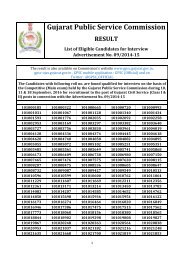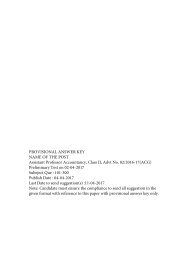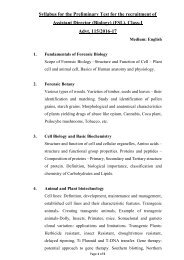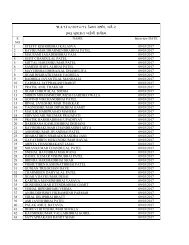પ્રાધ્યાપક
1EI6C6H_Syllabus%20Advt.%20No.%2086-2016
1EI6C6H_Syllabus%20Advt.%20No.%2086-2016
Create successful ePaper yourself
Turn your PDF publications into a flip-book with our unique Google optimized e-Paper software.
જા.ક્ર. ૮૬/૨૦૧૬-૧૭<br />
જગ્યાન ું નામ : સરકારી કોલેજોમાું વનસ્પતિશાસ્ત્ર તવષયના મદદનીશ <strong>પ્રાધ્યાપક</strong>, વર્ગ-૨<br />
ભાર્-૧ અને ભાર્-૨ ના ૧૫૦ તમતનટના સુંય ક્િ પ્રશ્નપત્રની પ્રાથતમક કસોટીનો અભ્યાસક્રમ<br />
પ્રાથતમક કસોટીનો અભ્યાસક્રમ<br />
ભાર્-૧<br />
માધ્યમ: ગ જરાિી<br />
ક લ પ્રશ્નો ૧૦૦ ક લ ગ ણ :૧૦૦<br />
૧<br />
ભારિની ભ ૂર્ોળ- ભૌર્ોલલક, આતથિક, સામાજજક, ક દરિી સુંસાધન અને વસ્િી અંર્ેની બાબિો- ગ જરાિના<br />
ખાસ સુંદભગ સાથે<br />
૨ ભારિનો સાુંસ્કૃતિક વારસો- સાહિત્ય, કલા, ધમગ અને સ્થાપત્યો- ગ જરાિના ખાસ સુંદભગ સાથે<br />
૩ ભારિનો ઈતિિાસ- ગ જરાિના ખાસ સુંદભગ સાથે<br />
૪ ભારિની અથગવ્યવસ્થા અને આયોજન<br />
૫ ભારિીય રાજનીતિ અને ભારિન ું બુંધારણ:<br />
(૧) આમ ખ<br />
(૨) મ ૂળભ ૂિ અતધકારો અને ફરજો<br />
(૩) રાજ્યનીતિના માર્ગદશગક તસદ્ાુંિો<br />
(૪) સુંસદની રચના<br />
(૫) રાષ્ટ્રપતિની સત્તા<br />
(૬) રાજ્યપાલની સત્તા<br />
(૭) ન્યાયિુંત્ર<br />
(૮) અન સલચિ ૂ જાતિ, અન સલચિ ૂ જનજાતિ અને સમાજના પછાિ વર્ો માટેની જોર્વાઈઓ<br />
(૯) એટની જનરલ<br />
(૧૦) નીતિ આયોર્<br />
(૧૧) પુંચાયિી રાજ<br />
(૧૨) નાણા પુંચ<br />
(૧૩) બુંધારણીય િથા વૈધતનક સુંસ્થાઓ- ભારિન ું ચુંટણી ૂ પુંચ, સુંઘ લોક સેવા આયોર્, રાજ્ય લોક<br />
સેવા આયોર્, કોમ્પ્ટ્રોલર એન્ડ ઓહડટર જનરલ; કેન્રીયસિકગિા આયોર્, લોકપાલ િથા<br />
લોકાય ક્િ અને કેન્રીય માહિિી આયોર્<br />
૬ સામાન્ય બૌદ્ધદ્ક ક્ષમિા કસોટી<br />
૭ સામાન્ય તવજ્ઞાન, પયાગવરણ અને ઈન્ફમેશન એન્ડ કોમ્પ્ટય તનકેશન ટેકનોલોજી<br />
૮ ખેલ જર્િ સહિિ રોજબરોજના પ્રાદેતશક, રાષ્ટ્રીય અને આંિરરાષ્ટ્રીય મિત્વના બનાવો<br />
*********
Syllabus of Preliminary Test<br />
part-1<br />
Medium: Gujarati Total que-100 Total Marks- 100<br />
1 Geography of India-Physical, Economic, Social, Natural Resources and population related<br />
topics- with special reference to Gujarat<br />
2 Cultural heritage of India-Literature, Art, Religion and Architecture- with special<br />
reference to Gujarat<br />
3 History of India with special reference to Gujarat<br />
4 Indian Economy and Planning<br />
5 Indian Polity and the Constitution of India:<br />
(1) Preamble<br />
(2) Fundamental Rights and Fundamental Duties<br />
(3) Directive Principles of State Policy<br />
(4) Composition of Parliament<br />
(5) Powers of the President of India<br />
(6) Powers of Governor<br />
(7) Judiciary<br />
(8) Provisions for Scheduled Castes, Scheduled Tribes and backward classes of the<br />
society<br />
(9) Attorney General<br />
(10) NITIAayog<br />
(11) Panchayati Raj Institutions<br />
(12) Finance Commission<br />
(13) Constitutional and Statutory Bodies: Election Commission of India, Union Public<br />
Service Commission, State Public Service Commission, Comptroller and Auditor<br />
General; Central Vigilance Commission, Lokpal and Lokayukta, Central<br />
Information Commission<br />
6 General Mental Ability<br />
7 General Science, Environment and Information & Communication Technology<br />
8 Daily events of Regional, National and International Importance including Sports<br />
*********
જાિેરાિ ક્રમાુંક ૮૬ /૨૦૧૬-૧૭<br />
ભાર્-૨ સુંબતધિ તવષયનો અભ્યાસક્રમ<br />
જગ્યાન ું નામ : સરકારી કોલેજોમાું વનસ્પતિશાસ્ત્ર તવષયના મદદનીશ <strong>પ્રાધ્યાપક</strong>, વર્ગ-૨<br />
ક લ પ્રશ્નો ૨૦૦ ક લ ગ ણ ૨૦૦ માધ્યમ: અંગ્રેજી<br />
1. Physiology:<br />
1. Absorption and translocation of water.<br />
2. Transpiration and stomatal behaviour.<br />
3. Absorption and uptake of Ions, Donnan’s equilibrium.<br />
4. Role of micronutrients in plant growth.<br />
5. Solute transport and photoassimilate translocation – uptake, transport and<br />
translocation of water, ions, solutes and macromolecules from soil, through<br />
cells, across membranes, through xylem and phloem; transpiration;<br />
mechanisms of loading and unloading of photoassimilates.<br />
6. Respiration (Glycolysis, pentose phosphate shunt, structure and role of<br />
mitochondria, Krebs cycle, Oxidative phosphorylation, Photorespiration,<br />
Respiratory quotient, Fermentation, Pasteur effect Factors affecting).<br />
7. Photosynthesis: - light and dark reaction, Red drop, Emerson effect, Two<br />
pigment systems, Mechanism of Hydrogen transfer, Calvin cycle, Enzymes<br />
of CO2 reduction, Hatch a slack cycle C4 cycle, CAM Pathway, Factors<br />
affecting photosynthesis, Pigments.<br />
8. The enzymes: Nomenclature and classification, structure and composition,<br />
Mode of enzyme action, Factors affecting.<br />
9. Nitrogen Metabolism and biosynthesis of proteins, Nitrogen fixation,<br />
Nitrogen cycle, (Physical and biological) Nitrogen assimilation Amino<br />
acid, metabolism, Biosynthesis of proteins.<br />
10. Plant hormones - Biosynthesis, storage, breakdown and transport;<br />
physiological effects and mechanisms of action. Auxins, Gibberellins,<br />
Cytokinins, Abscissic acid (General account).
11. Sensory photobiology - Structure, function and mechanisms of action of<br />
phytochromes, cryptochromes and phototropins; stomatal movement;<br />
photoperiodism and biological clocks.<br />
12. Stress physiology – Responses of plants to biotic (pathogen and insects)<br />
and abiotic (water, temperature and salt) stresses. Light stress and<br />
Temperature stress- Injury and resistance<br />
13. Plant movements: Hydrotropism, Geotropism, Phototropism,<br />
Thigmotropism<br />
2. Anatomy and Cell Biology:<br />
1. Ultra structure of the cell and cell organelles along with their functions.<br />
2. Cell wall structure.<br />
3. Tissue and Tissue systems, Complex tissue (Xylem and Phloem).<br />
4. Root development: lateral roots; root hairs; root-microbe interaction. Leaf<br />
– fall, Root – stem transition<br />
5. Meristems – Shoot and root apices.<br />
6. Normal and Anamalous Secondary growth, Abnormal behavior of normal<br />
cambium, Accessory cambium formation and its activity, Abnormal<br />
secondary growth in fleshy roots<br />
7. Types of stele – Stelar growth<br />
8. Nodal Anatomy – Unilacunar, Trilacunar, Multilacunar<br />
3. Algae (Phycology)<br />
1. Introduction and general classification of Algae.<br />
2. Criteria for the classification.<br />
3. Thallus organization in Algae.<br />
4. Economic importance of Algae.<br />
5. General characters, structure, Reproduction, pigments, phylogeny, life<br />
cycles etc., of main groups in Algae with reference to Genera Given:<br />
(a) Cyanophyceae (Nostoc, Scytonema, Oscillatoria).<br />
(b) Chlorophyceae (Chlamydomonas, Volvox, Cladeopora, Oedogonium,<br />
Coleochaete, Chara).<br />
(c) Bacillariaphyceae – General Account.<br />
(d) Xanthophyceae – Vautheria]
(e) Phaeophyceae (Ectocarpus, Laminaria)<br />
(f) Rhedophyceae (Polysiphonia, Gracillaria)<br />
4. Fungi (Mycology):<br />
1. General Characters of fungi. Occurrence and thallus structure of fungi.<br />
Nutritional aspects of Fungi (Saprophytism, parasitism, Symbiosis).<br />
Modes of reproduction (Sexual and Asexual). Life cycle in fungi. Criteria<br />
for classification of fungi. Classificatory systems.<br />
2. General characters, morphology, reproduction, phylogeny,<br />
affinities etc., of the following : main groups with special<br />
reference to Genera given below:<br />
a) Mytomycetes (stemonites).<br />
b) Plasmodiophoromycetes (Plasmodiphora).<br />
c) Mastigormycotina (Saprolegnia, Phytopthera).<br />
d) Zygomycotina (Mucor).<br />
e) Ascomycotina (Taphnina Eurotium, Erysiphe, Pleospora Neuropora).<br />
f) Basidiomycotina (Puccinia, Agaricus).<br />
g) Deuteromycotina (Cercospora, Colletotrichum, Phoma).<br />
3. Economic importance of Fungi.<br />
5. Bryophyta:<br />
1. General characters of Bryophyta.<br />
2. Sporophyte evolution in Bryophytes.<br />
3. Classification of Bryophytes.<br />
4. General account of the following main groups.<br />
a) Hepaticopsida, (b) Anthoceratopsida, (c) Bryopsida.<br />
5. Structure, reproduction and systematics of the following genera:<br />
a) Marchantia, (b) Anthoceros, (c) Sphagmum (d) Funaria.<br />
6. Pteridophyta:<br />
1. General characters of pteridophytes.<br />
2. Classification of pteridophytes.<br />
3. General characters of the following main groups:
a) Psilopsida; b) Lycopsida; c) Sphenopsida (Eusporangiate and<br />
Leptosporangiates):<br />
4. Morphology, anatomy, reproduction and affinities of the following genera:<br />
a) Psilotum; b) Lycopodium; c) Selaginella; d) Ophioglostum; e) Marsilea;<br />
f) Pteris.<br />
7. Palaeobotany:<br />
1. Fossil pteridophytes .<br />
2. Origin and evolution of land plants.<br />
3. Homospory, Heterospory and Origin of Seed.<br />
4. Telome theory and origin of sporophyte.<br />
5. General account of the following fossil Gymnosperms.<br />
a) Pteridosperms; b) Bennittitales; c) Cordaitales;<br />
d) Pentoxylales.<br />
8. Gymnosperms:<br />
1. Gymnosperms.<br />
2. Comparative account of morphology, life history, Affinities etc. of the<br />
following:<br />
a) Cycadophyta – Cycas, Zarnia,<br />
b) Coniferophyta – Pinus.<br />
c) Ginkgophyta – Gintgo.<br />
d) Chlamydospermatophyta: Ephedra, Welwetschia, Gnetum.<br />
3. Classification of Gymnosperms.<br />
9. Taxonomy of Angiosperms:<br />
1. Morphology: Types of Leaf and phyllotaxy,<br />
2. Systems of classification: - Hutchinson, Takhtajan, Bessey, Engler and<br />
Prantl, Bentham and Hooker.<br />
3. Principles of taxonomy:- Criteria of classification, categories of<br />
classification, Diversity of Phyletic concepts.<br />
4. International code of Botanical nomenclature, principles, Typification,<br />
Citation and authority.<br />
5. Recent trends in Taxonomy:
a) Biosystematics; b) Chemataxonomy; c) Serodiagnostic test and<br />
classification, d) Numerical taxonomy.<br />
6. Study of the following families with reference to their characterstics,<br />
economic importance, attributes etc.,<br />
a) Ranuculacease, b) Caryophyllaceae, c) Sterculiaceae,<br />
d) Sapotaceae, e) Malvaceae, f) Tiliacee, g) Rubiaceae,<br />
h) Compositae, i) Apocynaceae, j) Asclepiadaceae,<br />
k) Boraginaceae, l) Convolvulaceae, m) Solanaceae,<br />
n) Euphorbiaceae, o) Poaceae.<br />
10. Embryology:<br />
1. Concept of primitive flower.<br />
2. Development of anther and ovule.<br />
3. General account of Embryosac and types of Embryo.<br />
4. Structure of microsporangium and male gametophyte.<br />
5. Structure of ovule and its types.<br />
6. Structure of megasporangium and female gametophyte.<br />
Monosporic, Bisporic, Tetrasporic (Fritillaria type).<br />
7. Pollination in Salvia and Calotropis.<br />
8. Fertilization.<br />
9. Endosperm morphology and types, Types and functions of Endosperms<br />
10. Polyembryony and apomixis.<br />
11. Palynology : Exine ornamentation, concept of palynogram, Application of<br />
Palynology in Taxonomy, coal, oil exploration and forensic science,<br />
Germination of pollen tube and factors affecting pollen germination<br />
12. Embryo development in Dicotyledons, Embryo development in<br />
Monocotyledons<br />
13. Apomixis<br />
11. Cytology, Genetics and Evolution:<br />
1. Mitosis and Meiosis.<br />
2. Chromosome (Morphology, Structures importance etc.).<br />
3. Concept of gene, laws of inheritance gene action<br />
4. Mendelian genetics (Monohybrid, Dihybrid ratio).
5. Gene interactions (Complementary and Supplementary genes).<br />
6. Cytoplasmic inheritance: (Mirabilis, male sterility in maize)<br />
7. Sex determination in plants.<br />
8. Genetic code.<br />
9. Linkage and crossing over.<br />
10. Parasexuality.<br />
11. General account of Mutations<br />
12. Polyploidy and its role in crop improvement.<br />
13. Origin of life.<br />
14. General account and techniques of gene mapping<br />
15. DNA and RNA Composition and Structure, DNA sequencing, Watson<br />
and Crick’s model of DNA, Types of RNA, DNA Replication, Protein<br />
Synthesis<br />
16. Regulation of gene expression in prokaryotes – Operon concept<br />
17. Genetics Structural heterozygote, complex translocations of heterozygote<br />
18. Transposable elements<br />
19. Mitochondria and chloroplast genome<br />
12. Ecology and Phytogeography:<br />
1. Edaphic factors: Composition of soil, origin and development of soil, soil<br />
moisture, soil profile, soil erosion and soil conservation.<br />
2. Biological clock<br />
3. Remote sensing<br />
4. Heterotrophic nutrition in plants.<br />
5. Ecological adaptation in Hydrophytes and Xerophytes.<br />
6. Ecosystem: - Concept, biotic and abiotic components, ecological pyramids,<br />
productivity.<br />
7. Geo-chemical cycles. (Carbon, Nitrogen, Sulphur, Phosphorous cycles).<br />
8. Plant succession – Xerosere and Hydrosere.<br />
9. Floristic regions of the world.<br />
10. Floristic zones of India.<br />
13. Bacteria and Viruses:
1. General Account of viruses. Definition, Characterisation, Chemistry,<br />
Ultrasturcture, Composition, replication, Bacteriaphages, transmission of<br />
plant viruses, Importance.<br />
2. General account of bacteria – Characteristics, shape, ultrastructure of the<br />
cell, nutrition, reproduction, classification and importance.<br />
14. Plant Pathology:<br />
1. Disease symptoms produced by Bacteria, Fungi, and Viruses.<br />
2. A general account of important diseases of crop plants and their control:<br />
a) Late blight of potato f) Leaf spot of rice.<br />
b) Smuts (Wheat, Jowar) g) Citrus cancer<br />
c) Rust of wheat h) Bacterial blight of paddy.<br />
d) Leaf spot of groundnut. i) Angular leaf spot of cotton.<br />
e) Paddy blast. j) Mosaic of Tobacco.<br />
3. Mycoplasma.<br />
4. Control of plant diseases (A general account)<br />
15. Economic Botany:<br />
1. A brief introduction of medicinal plants and their chief constituents:<br />
Turmeric, Ephedra, Adhatoda,Terminalia chebula, Tinospora, Isaphgul.<br />
2. Firewood species:<br />
a. Prosopis spp.<br />
b. Holoptelia integrifolia<br />
c. Zizyphus jujuba<br />
d. Acacia nilotica.<br />
e. Salvadora persica.<br />
3. A concise account of Tobacco<br />
4. Cultivation, economic importance, systematic position and morphology,<br />
climate and uses of the following plants.<br />
Rice, Sugarcane, Coffee, Rauwolfia, Wheat, Groundnut, Tea, Pigeon pea,<br />
Jowar, Sun flower, Jute, Pearl millet, Cotton, Castor, Cardamom, Maize,<br />
Bajra, Tuver, Sesamum, Coir<br />
5. Botanical name, family, useful part, chemical constituents and uses:<br />
Condiments and Spices Cardamom, Chilies
Medicinal and Aromatic plants: Lemon grass, Cumin<br />
General account of dyes: Henna, Indigofera, Butea<br />
6. Habit, Habitat, Family, Botanical name, Useful parts and uses of the<br />
following Timber species:<br />
i.Tectona grandis<br />
ii.Dalbergia sissoo<br />
iii.Gmelina arborea<br />
iv.Madhuca indica<br />
v.Azadirachta indica.<br />
7. Habit, Habitat, Family, Botanical name, Useful parts and uses of the<br />
following Essential oils – Sandalwood, Eucalyptus, Jasmine, Kewra.<br />
8. A general account of organic manure.<br />
16. Biotechnology and Genetic Engineering:<br />
1. Application of Biotechnology in health and agriculture: Human insulin and<br />
vaccine production, gene therapy; Genetically modified organisms-BT<br />
crops; Transgenic Organisms; Artificial Seeds from plants, Edible<br />
Vaccines from plants<br />
2. Methods of gene transfer in plants: Micro ejection, electroporation, particle<br />
gun and Agrobacterium-mediated gene transfer<br />
3. Secondary plant products with special reference to alkaloids<br />
4. Cryopreservation and Germplasm storage<br />
17. Recent Aspects of Botany:<br />
1. Modern techniques<br />
a) Electron microscopy, e) Electrophoresis<br />
b) Phase contrast microscopy f) The tracer technique<br />
c) Spectro photometry g) Auto radiography<br />
d) Chromatography h) Sero-diagnostic methods.<br />
2. Genetic engineering.<br />
3. Plant tissue culture.<br />
4. Alternative sources of Energy.<br />
5. Social forestry.<br />
6. Microorganisms as tools in understanding biological systems.
7. Environmental pollution (Water, soil, air) health hazards and control.<br />
8. EthnoBotnay<br />
18. Silviculture<br />
General Principles, Systems, Natural and Artificial regeneration of Forest, Tree<br />
Physiology and Breeding, Silviculture for Mangroves and Shoreline Vegetation,<br />
Traditional and recent advances<br />
19. Recent Advancements and development in the field of research on above<br />
topics
















